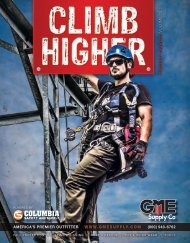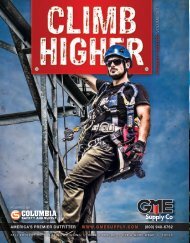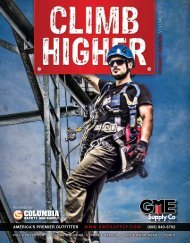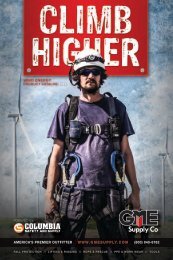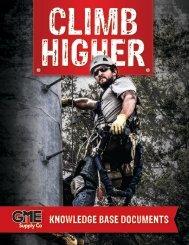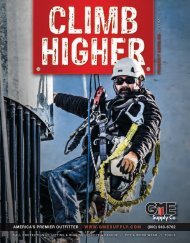GME Supply Catalog Version 19.4
GME Supply is North America's premier outfitter of fall protection, safety equipment, and gear for at-height workers, industry, and construction.
GME Supply is North America's premier outfitter of fall protection, safety equipment, and gear for at-height workers, industry, and construction.
Create successful ePaper yourself
Turn your PDF publications into a flip-book with our unique Google optimized e-Paper software.
RESPIRATOR 101
When working in hazardous environments or with
hazardous materials, taking every precaution to
protect your lungs is essential. Respirators are
designed to filter out specific particles, chemicals,
or vapors, to prevent them from causing injury,
illness, or worse.
WHAT ARE THE
HAZARDS?
Determining hazards present in a particular job is
the first step to selecting a respirator. Each type
of respirator has features designed to mitigate the
risk associated with various airborne irritants.
SOME COMMON HAZARDS ARE:
Particulates - silica, hazardous dust and fibers
Welfume - stainless and galvanized steel
Lead
Asbestos/Mold
Bleach/Ammonia - General cleaning products
Pesticides/Insecticides
Solvents - Water based latex
Chemicals - Sulfur dioxide, chlorine, ammonia
While this is not a complete guide for every
hazard you might encounter, it cannot be stressed
enough the importance of matching the respirator
and filter with the hazards present.
ASSESS THE SITUATION
Next, the jobsite should be assessed for overall
employee exposure. Do all workers on the site
need respiratory protection or just those in the
immediate area of the hazard?
DISPOSABLE
Air quality is typically measured in parts per
million (ppm) or milligrams per cubic meter of
air (mg/m3). Specific guidelines are outlined in
OSHA’s Respiratory Protection Standard 29 CFR
1910.134.
LEVEL OF PROTECTION
Depending on the type of hazard, and level
of exposure, you may need a specific style of
respirator.
THERE ARE THREE MAIN TYPES:
Disposable, Half Mask, and Full Face.
Disposable respirators are the most basic form
and provide short-term protection. They may not
be suitable for all types of hazards.
Half mask and full face respirators are usually
reusable and provide more protection. They also
add the convenience of having replaceable filters
to swap out for different protection needs.
For even more hazardous environments, there
are also supplied air systems which completely
supplement the air in the work environment for
clean, safe air.
FILTERS
The filter of the respirator allows air to flow
through, but blocks the hazards. Disposable
respirators come with a built in filter, where half
and full face respirators have removable filters
which can be changed based on the hazard, or
replaced when they become worn out.
HALF MASK
FILTERS CAN
HAVE 1 OF 3
LETTER CLASS
RATINGS:
Class N - Not oil resistant
Class R - Resistant to oil
Class P - Oil proof
They also use a 3 number rating system, based
on how well they filter particles measuring 0.3
microns or larger in diameter.
95 - Filters 95% of all particles
99 - Filters 99% of all particles
100 - Filters 100% of all particles.
These two filter classes are typically noted in this
form: N95, P100, etc.
FIT
When wearing a respirator, it is essential that it
fit correctly. A user should be fit to ensure that
they have selected the proper size and style of
respirator. This test should be administered by a
trained person, and repeated regularly.
A seal check should be performed each time the
respirator is donned, to check for gaps that allow
air to pass between the face and the face seal.
STANDARDS
OSHA only allows respirators approved by the
National Institute for Occupational Safety and
Health (NIOSH) for workplace use.











